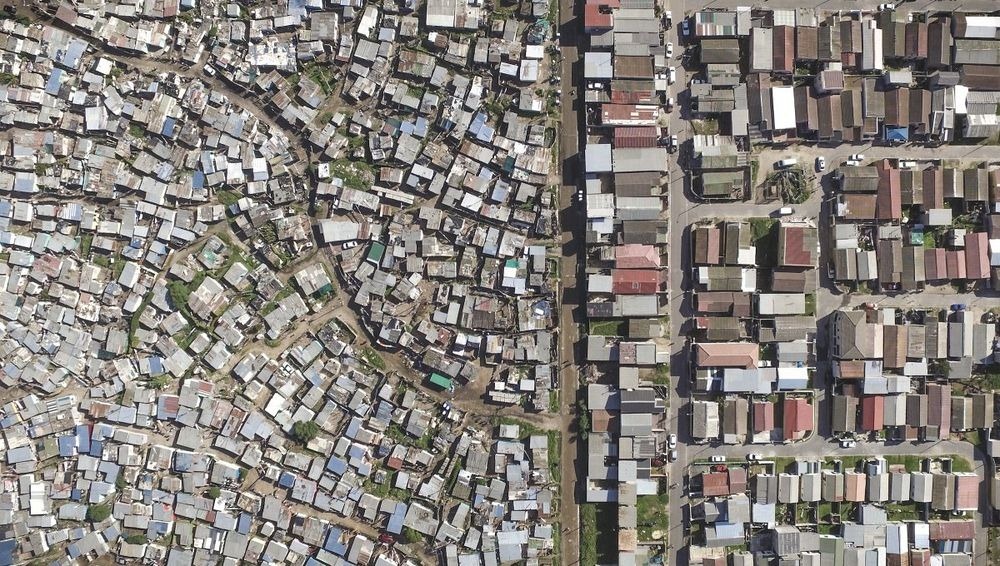Although South Africa’s apartheid era ended more than twenty years ago, there is still a palpable economic tension between the blacks and the whites. The black majority occupies the bottom rung of the society where they continue to be confronted by deep poverty, unemployment and inequality. The economic divide gets even more tangible once you get airborne. That’s what American Photographer Johnny Miller, who now lives in Cape Town, wanted to capture when he began his photo series “Unequal Scenes”.
“Drone photography is interesting because it affords people a new perspective on places they thought they knew,” Miller told CityLab. “Humans have this amazing ability to think we know a situation, having seen it so many times from the same perspective. It becomes routine, almost a pattern. When you fly, you totally change that.”
“I wanted to disrupt that sense of complacency that I felt, and that I knew a lot of privileged people in Cape Town feel,” he said.
So Miller took his drone to some of the most contrasting neighborhoods of Cape Town, such as Masiphumelele, a community of some 38,000 people, most living in small tin-roofed shacks. Just next to the impoverished area is Lake Michelle, an upscale suburban neighborhood where properties run into millions of dollars.
“I can tell you that it (segregation, inside Cape Town’s urban settlements) is desperate,” Miller said. “In some cases, it is like an urban hell. There is disease, there is crime, there is unemployment, there is anger, and there is hopelessness. Not in every single case, but in many. And literally, in some cases, next door, there are all the wealthy pleasures of life. Internet. Cars. Comforts. Swimming pools. Access to wealth. Jobs. Hope.”
Some of these ultra-rich neighborhoods are physically divided from the seedy shacks, sometimes by electric fences and guardhouses, and sometimes by wetlands. Many of these communities were designed with separation in mind. Others have grown more or less organically.
Miller says that the problem is not limited to Cape Town. Similar contrasting scenes exist in other South African cities from Durban and Johannesburg.
All images by Johnny Miller
Related: Oscar Ruíz’s Aerial Photos of Mexico’s Rich And The Poor
























On which side do you live Johnny?
ReplyDeleteThe rich side, of course. He hails from Mukilteo, which according to Wikipedia, "is one of the most affluent suburbs of Seattle."
DeleteIncredible pictures. Hard to believe that apartheid ended over 2 decades ago and nothing much seems to have improved for a lot of people.
ReplyDeleteStill, even though Johnny lived in an affluent suburb of Seattle, he is thoughtful and brave enough to show the gross economic disparity in Cape Town. These incredibly poor people really need a large scale government support and assistance to give them opportunities to lift themselves out of abject poverty. But I can see at this starting point, which has been in place for an appalling 20 years, that the rich will fear they will lose their privileged life if South African blacks better themselves. Will they accept one day that blacks can live in much nicer houses and have access to large parks and golf courses? - Jeanne Wong, Calif. USA
ReplyDeleteGive them a fish and they will eat for a day. Teach them how to fish and they will eat for a life time.... They do not need a "Robin-hood" to rob from the rich and give stuff to the poor. They need SCHOOLS/Education.They need modern(2017)education SYSTEMS. Transportation to and from school, motivated teachers, school food programs,and up-to-date buildings.
ReplyDeleteIn no time at all the cream will rise to the top and the well educated will leave their ghettos for houses with pools of their own. Some will not go to school. Some will just sit there and protest for a hand-out.
This story goes on and on everyday worldwide (think Chicago, Baltimore,New York) It seems that 15/20% find a way out; 80% do not. We are stuck with
it. Go build a school someplace. Won't fix the greater problem... But it is a start. Putting ALL the blame on the rich just pisses them off. They are not the problem.